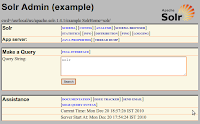
Apache Solr™ is our high performance enterprise search server, with XML/HTTP and JSON/Python/Ruby APIs, hit highlighting, faceted search, caching, replication, distributed search, database integration, web admin and search interfaces.
1. Install Java
yum install java
2. Download & Extract Solr
cd /usr/local/src
wget http://www.apache.org/dist//lucene/solr/1.4.1/apache-solr-1.4.1.tgz
tar -xzvf apache-solr-1.4.1.tgz
3. Download MySQL Java connector
wget http://mysql.spd.co.il/Downloads/Connector-J/mysql-connector-java-3.1.14.zip
unzip mysql-connector-java-3.1.14.zip
cd mysql-connector-java-3.1.14
cp mysql-connector-java-3.1.14-bin.jar /usr/local/src/apache-solr-1.4.1/example/lib/
4. Configure MySQL Database
Create a new xml file called data-import.xml , change the obvious variables to suit your DB. In this example, I am indexing a own DB table called users.
cd /usr/local/src/apache-solr-1.4.1/example/solr/conf
nano data-import.xml
put follow text
<dataconfig>
<datasource type="JdbcDataSource" driver="com.mysql.jdbc.Driver" url="jdbc:mysql://192.168.1.7/mydatabase" user="myuser" password="mypassword">
<document name="content">
<entity name="node" query="select user_id AS id, mobile AS mobile, user_status AS status FROM users">
<field column="id" name="id">
<field column="mobile" name="mobile">
<field column="status" name="status">
</field></field></field></entity>
</document>
</datasource>
</dataconfig>
5. Configure solr .
Edit file solrconfig.xml which is located in /usr/local/src/apache-solr-1.4.1/example/solr/conf directory. Add the following requestHandler entry if not already existing.
<requesthandler name="/dataimport" class="org.apache.solr.handler.dataimport.DataImportHandler">
<lst name="defaults">
<str name="config">data-config.xml</str>
</lst>
</requesthandler>
6. Now we will configure solr’s schema by editing schema.xml in /usr/local/src/apache-solr-1.4.1/example/solr/conf directory. Delete old
<fields>
<field name="id" type="string" indexed="true" stored="true" default="NOW" required="true">
<field name="mobile" type="text" indexed="true" stored="true" required="true">
<field name="status" type="text" indexed="false" stored="true" required="false">
</field></field></field></fields>
<uniquekey>id</uniquekey>
<!-- field for the QueryParser to use when an explicit fieldname is absent -->
<defaultsearchfield>mobile</defaultsearchfield>
7. Start SOLR
java -jar /usr/local/src/apache-solr-1.4.1/example/start.jar
Performing full or delta indexing
If everything works correctly, you can get solr to fully index the configured tables by accessing the following command via your browser. http://
You can check the status of the command by accessing http://
If everything works correctly, you can now search for data from http://
To do an incremental or delta indexing of data since the last full or delta, increment, issue the command http://
You can now access these xml results from your web application. There are client api’s available for RoR, php, java etc.
References
http://www.cabotsolutions.com/2009/05/using-solr-lucene-for-full-text-search-with-mysql-db/
http://www.ipros.nl/2008/12/15/using-solr-with-wordpress/
http://wiki.apache.org/solr/DataImportHandler#head-df246a3aed0bb38297f3449bc35a0bdf38a272b5
http://lucene.apache.org/solr/tutorial.html
1 comment:
The code posted doesn't work. XML is case-sensitive. requestHandler not requesthandler
Post a Comment